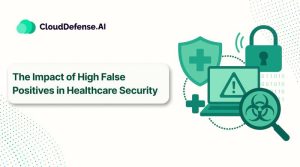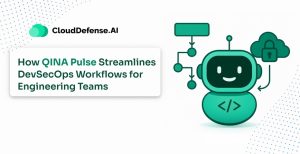Ever heard of those random security flaws that keep popping up in software and systems? Well, CVE is like a massive catalog that keeps track of them all. It’s a dictionary of publicly disclosed cybersecurity vulnerabilities, each with a unique identifier number. This standardized system helps researchers, vendors, and users communicate effectively about vulnerabilities and coordinate remediation efforts.
With new vulnerabilities discovered every day, CVE plays a crucial role in keeping the digital world secure by providing a common language for everyone to understand and address these weaknesses before they can be exploited by malicious actors.
Keep reading as we explore everything about CVE and its role in identifying and addressing security weaknesses in software and systems.
What is a CVE?
CVE stands for Common Vulnerabilities and Exposures, and it’s basically a dictionary of publicly known security flaws. Think of it like a massive encyclopedia, but instead of covering general topics, it catalogs all the vulnerabilities researchers have discovered in computer systems and software products.
Each vulnerability gets its own unique CVE ID number, which looks something like CVE-2022-12345. This standardized identification system helps everyone in the cybersecurity world speak the same language when referring to a specific vulnerability. It’s like having a common name for each flaw, so there’s no confusion about which vulnerability you’re talking about.
These CVE entries provide detailed information about the vulnerability, including a description of the problem, the affected products or versions, and sometimes even potential remedies or workarounds. Having this centralized database of vulnerabilities is crucial for coordinating responses and keeping everyone on the same page when it comes to cyber threats. It’s a valuable resource for both security professionals and regular folk alike who want to stay on top of the latest vulnerabilities and protect their systems.
Structure of a CVE Identifier
A CVE identifier, often shortened to CVE ID, acts like a unique fingerprint for a publicly known cybersecurity vulnerability. Understanding its structure helps you decipher the information encoded within it.
The format of a CVE ID is straightforward: CVE-YYYY-NNNNN
Here’s a breakdown of its components:
- CVE: This prefix stands for “Common Vulnerabilities and Exposures.” It signifies that the identifier belongs to the official CVE system.
- YYYY: This represents the year the CVE ID was assigned or the year the vulnerability was made public (whichever came first). It’s important to note that this doesn’t necessarily indicate when the vulnerability was discovered.
- NNNNN: This section is a unique sequence number assigned to the specific vulnerability. Originally, CVE IDs only used four digits (NNNN) but the system now allows for more digits (e.g., NNNNNN or even NNNNNNNN) to accommodate the growing number of vulnerabilities discovered each year.
For example, consider a CVE ID like CVE-2023-12345. This tells us that the vulnerability was either assigned a CVE ID or publicly disclosed in the year 2023, and 12345 is the unique sequence number assigned to this specific vulnerability within the CVE system.
Key Benefits of CVEs
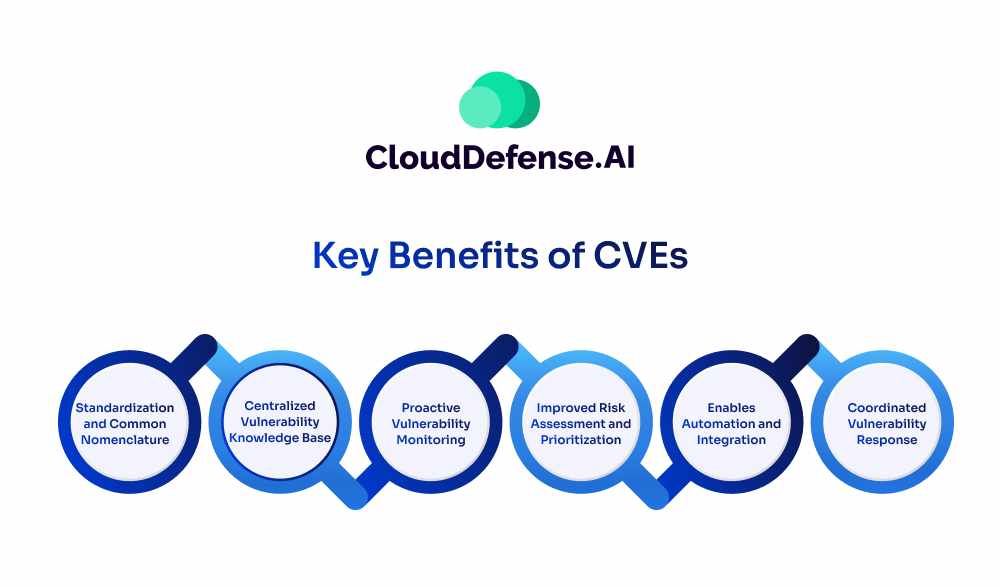
Standardization and Common Nomenclature
- CVEs provide a standardized naming and identification system for publicly disclosed cyber vulnerabilities
- Using unique CVE IDs eliminates confusion and allows clear communication about specific vulnerabilities
Centralized Vulnerability Knowledge Base
- The CVE database acts as a centralized repository documenting details about each vulnerability
- This avoids fragmentation and conflicting information across various sources
- Provides a single, authoritative reference for vulnerability data
Improved Risk Assessment and Prioritization
- CVE entries include metadata like severity scores, affected products/versions, and other contextual details
- This context allows organizations to better prioritize vulnerabilities based on actual risk exposure
- Enables more efficient allocation of remediation resources and efforts
Coordinated Vulnerability Response
- CVEs facilitate coordination among researchers, vendors, and impacted organizations
- Following CVE disclosures, all parties can respond in a timely, synchronized manner
- Vendors can develop and release patches promptly
Enables Automation and Integration
- CVEs are integrated into many security tools and vulnerability management solutions
- Scanners can automatically detect CVEs, patch management can track needed fixes, etc.
- Supports automation of vulnerability assessment and remediation workflows
Proactive Vulnerability Monitoring
- Organizations can continuously monitor new CVE additions that may be relevant
- By cross-referencing CVEs against their software inventory, vulnerabilities can be addressed proactively
- Reduces vulnerability exposure windows before active exploitation
What Qualifies to be a CVE?
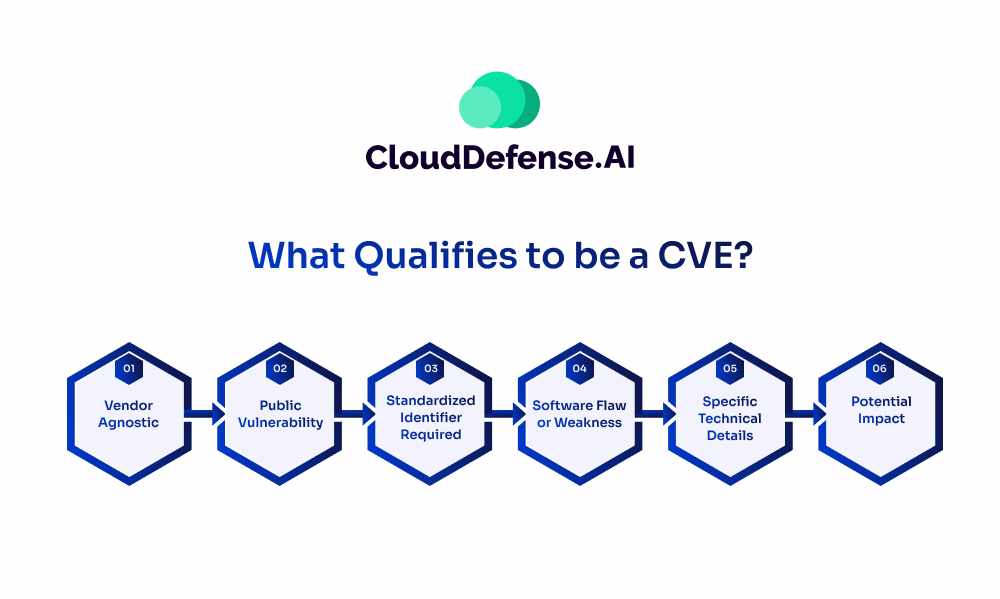
To qualify for a CVE (Common Vulnerabilities and Exposures) identifier, a vulnerability must meet certain criteria set by the CVE Program. Here are the main requirements:
Public Vulnerability
- The vulnerability must have been publicly disclosed or reported, not just privately known
- This allows coordinating analysis, patching, and mitigations
Software Flaw or Weakness
- The CVE must identify a specific bug, flaw, or weakness in software code/systems
- It cannot be for general policy, configuration issues, or theoretical vulnerabilities
Potential Impact
- The vulnerability needs to potentially allow unauthorized actions that can violate security policies
- This could include gaining privileges, access, denial of service, etc.
Specific Technical Details
- Enough technical details about the vulnerability should be available publicly
- This is to enable analysis, testing, and developing remediations
Vendor Agnostic
- While vendor products are listed, the CVE itself cannot be unique to a single vendor
- Vulnerabilities shared across multiple vendors’ products/components are eligible
Standardized Identifier Required
- Each CVE must have a standardized name following the CVE ID convention (e.g. CVE-2022-12345)
- This allows clear referencing and tracking of the specific vulnerability
Once a potential vulnerability meets these criteria, it can go through the CVE Numbering Authority process to get an official CVE ID assigned and published in the database with full details.
How Does the CVE System Work?
You might be wondering how this whole CVE system actually operates behind the scenes. Well, it’s a surprisingly organized and collaborative process! Here’s a breakdown of its key functionalities:
- CVE Numbering Authorities (CNAs): Not everyone can assign CVE IDs. The system relies on designated CNAs, typically security organizations or software vendors, to submit and manage CVE records.
- Reporting and Documentation: When a new vulnerability or exposure is discovered, researchers or security professionals submit a report to a CNA. The report details the nature of the threat, potential impact, and any available exploit code. The CNA then analyzes the report and, if deemed valid, assigns a unique CVE ID and creates a CVE record.
- CVE Record Structure: Each CVE record in the central CVE List contains vital information. This includes:
- CVE ID: The unique identifier in the format “CVE-YYYY-NNNNNN” (e.g., CVE-2023-12345).
- Description: A detailed explanation of the vulnerability or exposure, including the affected software, potential consequences, and how it might be exploited.
- References: Links to additional resources like vulnerability reports, vendor advisories, and patches.
- Public Availability: The CVE List is a public database maintained by MITRE, a non-profit organization, on behalf of the CVE community. Anyone can access the list and search for specific CVE IDs to learn more about known vulnerabilities.
The CVE system prioritizes efficiency and avoids duplication. Before assigning a new CVE ID, CNAs check the existing list to ensure the vulnerability hasn’t already been documented. This streamlined approach ensures all stakeholders are on the same page when discussing a specific security weakness.
How are CVEs Assigned and Managed?
The CVE system thrives on a collaborative effort between security researchers, software vendors, and a central governing body. Here’s a closer look at the process of assigning and managing CVEs:
CVE Numbering Authorities (CNAs): As the central governing body of the CVE program, MITRE Corporation, a not-for-profit organization operates as the main CVE database and content repository. They validate all the CVE entries submitted by CNAs before listing them publicly for the world to refer to. It’s kind of like a well-orchestrated supply chain! The CNAs are the suppliers who identify and document the vulnerabilities. MITRE reviews and processes those submissions, and pumps out the finalized CVE entries for publication and distribution.
Reporting and Vetting Process: When a vulnerability is discovered, researchers or security professionals submit a detailed report to a relevant CNA. This report typically includes:
- A clear description of the vulnerability: This explains the nature of the security weakness, how it can be exploited, and potentially affected software versions.
- Technical details and proof of concept (POC): In some cases, researchers may include technical details like exploit code to demonstrate the vulnerability’s validity.
- Severity assessment: An initial assessment of the vulnerability’s potential impact (critical, high, medium, etc.) can be helpful for prioritization.
The CNA then meticulously vets the report. This involves verifying the existence and validity of the vulnerability, ensuring it hasn’t already been documented with a CVE ID, and potentially requesting additional information from the reporter.
CVE ID Assignment and Record Creation: If the CNA confirms the validity of the reported vulnerability, they assign a unique CVE ID following the format “CVE-YYYY-NNNNNN” (e.g., CVE-2024-10001). Subsequently, they create a CVE record in the central CVE List. This record typically includes:
- The assigned CVE ID
- A detailed description of the vulnerability
- References to the original report, vendor advisories, and any available patches
Public Availability and Maintenance: The CVE List is a public database freely accessible on the CVE website. Anyone can search the list using CVE IDs or keywords to find information about specific vulnerabilities.
Who Reports CVEs?
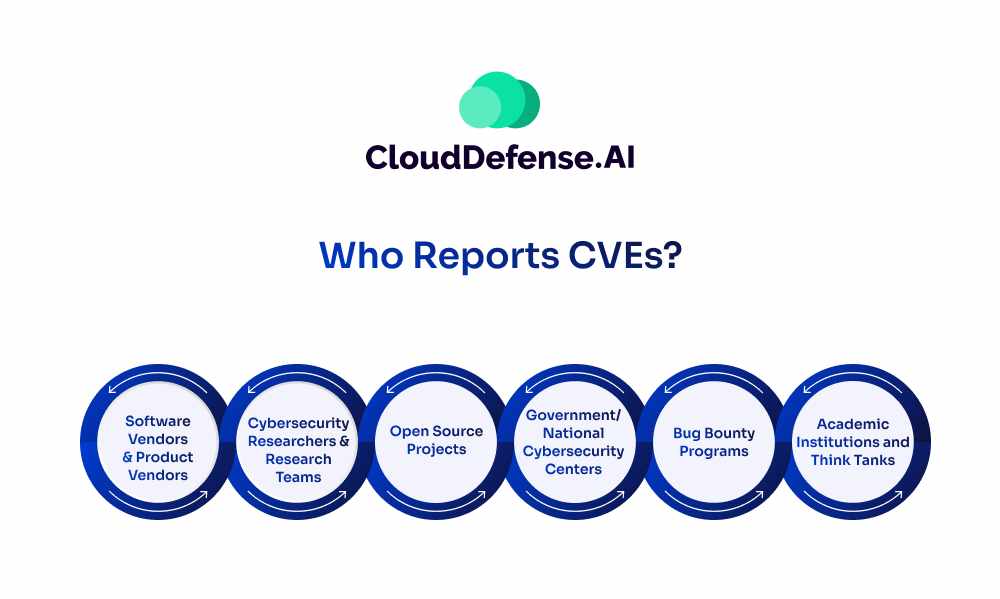
It’s important to note that CVE records are not static. As new information becomes available, the CNA responsible for the record can update it with details like exploit code disclosure, patch availability, or revised severity assessments. This ensures the information in the CVE List remains accurate and up-to-date.
CVEs (Common Vulnerabilities and Exposures) are reported and submitted by authorized CVE Numbering Authorities (CNAs). Here are some of the main entities that can report and get CVEs assigned:
Software Vendors and Product Vendors
- Companies like Microsoft, Apple, Google, etc. that develop software and products can report vulnerabilities found in their own offerings and get CVE IDs assigned.
- Vendors have a vested interest in disclosing vulnerabilities responsibly and providing patches.
Cybersecurity Researchers and Research Teams
- Individual security researchers or university/company research teams that discover new vulnerabilities can submit them for CVE assignment.
- This includes both independent researchers and vendor-employed security teams.
Open Source Projects
- Developers of open source software projects can report vulnerabilities in their codebases and libraries.
- Many open source projects have dedicated security teams monitoring for vulnerabilities.
Government/National Cybersecurity Centers
- Federal agencies like NIST, DHS, CERT/CC, etc. focused on cybersecurity can report vulnerabilities and get them CVE IDs.
- This helps coordinate disclosure and patching across both public and private sectors.
Bug Bounty Programs
- Researchers participating in bug bounty programs run by companies often submit valid vulnerabilities they find to get CVEs.
- Bug bounties incentivize finding and responsibly reporting flaws.
Academic Institutions and Think Tanks
- University research labs, think tanks, and other academic entities can report vulnerabilities they uncover.
- Their research often explores cutting-edge exploitation techniques.
To become an authorized CNA that can assign CVE IDs, organizations go through a vetting process managed by the CVE Program and its primary Content Decision Body (CDB) at MITRE.
The diversity of reporting entities helps ensure that vulnerabilities across all technologies, from consumer software to industrial systems, get discovered, analyzed and entered into the CVE list for remediation and mitigation.
Why are CVEs Important?
Imagine you’re running a small online store. You take pride in your website’s security, but you’re aware that vulnerabilities can exist in any software. This is where the CVE system comes in, acting as your early warning system and a roadmap for taking action.
Prioritizing Threats: The CVE system doesn’t just list vulnerabilities; it helps you understand their severity. Many CVEs reference a scoring system called CVSS (Common Vulnerability Scoring System). CVSS assigns a score based on factors like exploitability, potential impact, and ease of remediation. This allows you to prioritize which vulnerabilities to address first, focusing on those with the highest potential for causing damage.
Taking Action: Once you identify a relevant CVE (perhaps through a security scan or news report), the CVE record itself becomes your roadmap. The record will typically include links to:
- Vendor Advisories: These advisories, issued by software companies, detail the vulnerability, potential impact on their products, and most importantly, any available patches or mitigation strategies.
- Exploit Code: In some cases, the record might reference publicly available exploit code. This information, while concerning, empowers security professionals to test their defenses and identify weaknesses before attackers can exploit them.
Let’s Consider a Scenario:
Let’s say you receive a notification from your website security scanner about a vulnerability identified in your shopping cart software. The scanner also mentions a corresponding CVE ID – CVE-2024-25468. Here’s how the CVE system helps you:
- Prioritization: You search the CVE List for CVE-2024-25468. The description reveals it’s a critical vulnerability that could allow attackers to steal customer credit card information. Given the severity, you know this needs immediate attention.
- Action: The CVE record links to an advisory from the shopping cart software vendor. The advisory confirms the vulnerability and thankfully, also provides a patch that you can install to fix the issue.
Therefore, by efficiently identifying, prioritizing, and providing resources to address vulnerabilities, the CVE system empowers individuals and organizations to take proactive steps and maintain a strong cybersecurity posture.
How Many CVEs Are There?
With new security vulnerabilities being discovered practically every day across thousands of software products and systems, you might expect the number of CVEs to be dizzying. And you’d be absolutely right!
Here’s a glimpse into the vast landscape of CVEs:
- Millions and Counting: The CVE program has been diligently documenting and assigning unique identifiers to publicly disclosed vulnerabilities since 1999. In those early years, the volume was relatively modest—just a few hundred new CVEs published annually. As of today (May, 2024), the National Vulnerability Database (NVD) maintained by NIST lists over 248,800 CVE identifiers. This number reflects the cumulative total since the CVE program’s inception in 1999.
- A Yearly Surge: With the ever-increasing complexity of software and the relentless pursuit of vulnerabilities by security researchers, the number of newly discovered CVEs reported each year is significant. On average, 12,000 to 15,000 new CVEs are documented annually.
- Not All Vulnerabilities Are Created Equal: It’s important to remember that not all CVEs represent equally critical threats. The severity of a vulnerability can vary greatly, and some may even be theoretical with a low likelihood of exploitation.
Here are some resources for staying updated on the CVE landscape:
- National Vulnerability Database (NVD): https://nvd.nist.gov/vuln/search
- MITRE CVE List: https://cve.mitre.org/
Difference between CVE and CVSS table form
CVE (Common Vulnerabilities and Exposures) and CVSS (Common Vulnerability Scoring System) are two closely related but distinct concepts in the context of cybersecurity vulnerabilities:
| Feature | CVE (Common Vulnerabilities and Exposures) | CVSS (Common Vulnerability Scoring System) |
| Definition | Identifier for a publicly known vulnerability | Scoring system for vulnerability severity |
| Function | Provides a common language for discussing vulnerabilities | Helps prioritize vulnerabilities based on risk |
| Information Provided | Details about the vulnerability (description, affected software, references) | Score reflecting exploitability, impact, and remediation ease |
| Assigns Severity | No | Yes (score from 0.0 to 10.0) |
| Focus | Identification and communication | Risk assessment and prioritization |
| Example | CVE-2024-12345 identifies a specific vulnerability | A CVSS score of 9.8 indicates a critical vulnerability |
| Maintained by | MITRE Corporation | FIRST (Forum of Incident Response and Security Teams) |
Bottom Line
Throughout this article, we’ve delved into the world of CVE identifiers, equipping you to understand and leverage them for stronger cybersecurity. Remember, CVEs act as a common language for pinpointing vulnerabilities, while the CVE system itself provides a central resource for managing them. By understanding CVEs, you can be your own cybersecurity detective, sniffing out potential threats and taking action before anything bad happens. Stay curious, stay informed, and most importantly, stay safe out there!


